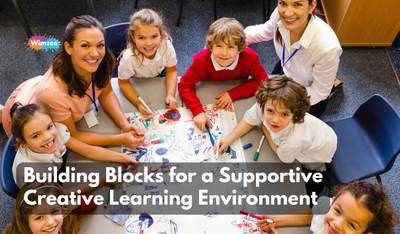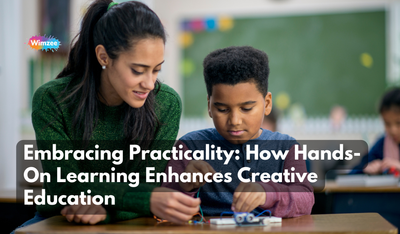Imagine a learning space where every corner is designed to spark creativity and bolster confidence in young creatives. Whether it's a classroom buzzing with innovative ideas or a quiet corner at home tailored for thoughtful reflection, the environment plays a pivotal role in nurturing the creative spirits of children. This blog explores practical steps to build such nurturing spaces, tailored for various learning styles and needs, including those of special learners.
The Essentials of a Supportive Learning Environment
Creating a supportive learning environment is fundamental to enhancing student engagement, self-esteem, and overall academic performance. This environment is not just about physical spaces but also involves emotional support and fostering a culture of respect and understanding among students.
Emotional and Physical Safety
At the core of a supportive learning environment is the safety of students—both emotionally and physically. Schools and educators must prioritize creating spaces where students feel secure and valued. This includes maintaining a clean, organized classroom free from physical hazards, and addressing students' emotional needs through empathy and active support (The Will to Teach).
Open Communication and Respect for Diversity
Open communication is vital in educational settings. It helps in building trust and understanding between students and educators. Teachers should encourage students to express their thoughts and opinions freely and ensure that these opinions are respected, regardless of the students' backgrounds. By valuing diversity, educators teach students to appreciate various cultures and perspectives, which enriches the learning experience for everyone involved (The Will to Teach) (Cambridge University Press & Assessment).
A "Yes Environment"
Another important aspect is creating a 'Yes Environment,' a concept that revolves around respecting children’s choices and encouraging their independence. This approach helps foster creativity and confidence as students feel more in control of their learning experiences. In such environments, mistakes are seen as part of the learning process, and students are encouraged to explore and express their ideas without fear of judgment (The Will to Teach) (British Red Cross).
Incorporating Social-Emotional Learning
Implementing social-emotional learning is crucial. This includes teaching skills like empathy, self-regulation, and conflict resolution. These skills not only support a respectful and understanding classroom climate but also equip students with the ability to manage their interpersonal relationships and challenges outside of school (The Will to Teach) (Home).
Effective Use of Feedback
Feedback in a supportive learning environment should be constructive and aimed at encouraging students. It's not just about pointing out what is wrong; it is equally important to acknowledge what students are doing right. Effective feedback helps build a student's confidence and fosters a deeper engagement in their educational journey, enhancing both their school identification and behavioral engagement (Frontiers).
By focusing on these key elements, educators can create a nurturing atmosphere that significantly boosts learning outcomes and prepares students not just academically but socially and emotionally as well.
Creative Teaching Techniques
Innovative and creative teaching methods are crucial for fostering an environment that nurtures the diverse creative inclinations of students. These techniques not only support critical thinking and problem-solving skills but also integrate technology to enhance learning experiences. Here's a look at some dynamic methods to bring creativity into the classroom.
Hands-On Learning: Jigsaw and Peer Teaching
Jigsaw Technique: This method involves students working in groups to learn different segments of a topic and then teaching it to their peers. By exploring a subject from multiple angles, students develop a deeper understanding and retain information better (AhaSlides).
Peer Teaching: Allowing students to teach each other encourages mastery of the subject and improves communication skills. This method boosts confidence and fosters a sense of responsibility among students as they prepare to explain concepts clearly and concisely to their classmates (AhaSlides).
The Role of Technology: Flipped Classrooms and Cloud Computing
Flipped Classroom: This innovative strategy flips the traditional learning environment by having students prepare before class through videos or readings. Classroom time is then dedicated to exercises, discussions, and application of knowledge, allowing for deeper engagement and personalized learning experiences (AhaSlides).
Cloud Computing: Utilizing cloud-based platforms enables flexible, accessible learning opportunities. Students can access materials and lessons from anywhere, fostering an environment conducive to learning at their own pace and according to their own schedules (AhaSlides).
Encouraging Creativity Through Mindfulness and Brainstorming
Mindfulness in Education: Integrating mindfulness practices in the classroom can significantly enhance creativity. Exercises like mindfulness meditation help students clear their minds, leading to improved focus and higher creativity in problem-solving tasks (TED-Ed Blog) (Canva).
Brainstorming Sessions: Regular brainstorming encourages students to think outside the box and propose a variety of solutions to problems. This activity is essential for developing critical thinking skills and allows students to explore and refine their ideas in a supportive setting (CELT at Iowa State) (Canva).
By adopting these creative teaching techniques, educators can cater to various learning styles and foster an environment that encourages students to think creatively and critically. This approach not only makes learning more engaging but also equips students with the skills necessary for success in a rapidly changing world.
Fostering Creativity Through Adaptive Learning Spaces
Adaptive learning spaces are transformative environments that cater to diverse educational needs and learning styles, enhancing creativity and interaction among students. These spaces are designed to be flexible, allowing for various activities and styles of learning, and they can greatly benefit all learners, including those with special needs.
Designing Flexible Learning Spaces
The key to fostering creativity in learning environments is flexibility. Schools are increasingly moving away from traditional classroom settings, incorporating multifunctional and flexible learning areas that encourage students to collaborate, explore, and engage in hands-on activities (KI) (Architecture & Design). Furniture in these spaces often includes movable pieces like desks on wheels and pivoting chairs, which can be rearranged to suit different activities and group sizes (cdispaces). This adaptability not only supports various learning modalities but also encourages students to take ownership of their learning environment.
Integrating Technology
In today’s educational landscape, technology integration is essential for creating adaptive learning spaces. Effective use of technology—from interactive displays to digital resources—supports a dynamic learning experience that can be tailored to individual student needs (cdispaces) (Architecture & Design). This integration helps minimize distractions and maximizes engagement, providing a platform for interactive and collaborative learning.
Encouraging Risk-Taking and Free Expression
Adaptive learning spaces are designed to make students feel comfortable and confident in taking risks and expressing themselves freely. These environments often include areas for quiet reflection as well as spaces for group discussion and creative projects, allowing students to navigate between different types of learning activities seamlessly (cdispaces) (Architecture & Design). Such design considerations not only support academic tasks but also cater to the emotional and social growth of students, which is crucial for creative development.
Special Considerations for Learners with Special Needs
Adaptive spaces can be particularly beneficial for learners with special needs, providing them with the resources and environment necessary to thrive. These spaces allow for personalization and adjustments that meet individual learning requirements, helping to reduce barriers and foster an inclusive educational atmosphere (cdispaces) (Architect). For example, the creation of ‘neighborhoods’ or learning communities within the school can help students with special needs feel more integrated into the school community, promoting better social interactions and collaborative learning experiences (Architect).
Overall, adaptive learning spaces represent a significant shift towards more inclusive, engaging, and flexible educational environments that respond to the needs of all students, fostering creativity and a love of learning in the process.
Feedback: The Keystone of Creative Growth
Feedback in educational settings is more than just a tool for correction; it is a powerful catalyst for student growth and motivation, particularly when it comes to nurturing creativity. Understanding the types of feedback and how they can be employed effectively is crucial in fostering a supportive and inspiring learning environment.
Types of Feedback and Their Impact
Formative Feedback: This type of feedback is ongoing and occurs during the learning process. It's aimed at improving learning by providing suggestions and support that help students reflect on their current knowledge and skills, understand their strengths, and identify areas for improvement. Studies have shown that formative feedback, particularly when it involves specific suggestions, significantly enhances creativity in students, as it helps them see alternative paths and solutions in their work (Frontiers).
Summative Feedback: This feedback is provided at the end of a learning period or project and evaluates student learning based on set outcomes. While it's more evaluative and less about ongoing improvement, it can help students understand the overall effectiveness of their efforts and assimilate learned knowledge into future tasks.
Best Practices for Providing Constructive Feedback
- Focus on the Process, Not Just the Product: Encourage a growth mindset by recognizing and discussing the effort and strategies that students use, not just the final outcome. This approach fosters an environment where creativity is seen as a process that can be developed and expanded over time (Frontiers).
- Be Specific and Actionable: Vague feedback like "good job" or "try harder" is less effective than detailed, actionable advice. Telling a student exactly what they did well, and where they can improve, makes it easier for them to apply these insights in future projects (OECD.org - OECD).
- Promote Autonomy and Agency: Feedback should empower students to take control of their learning. Encourage them to set goals for their improvement and involve them in the feedback process. This not only enhances their creative skills but also builds their self-efficacy and sense of agency (HundrED
). - Maintain a Positive Tone: Feedback should be constructive and delivered in a supportive, encouraging tone. This is crucial in maintaining student motivation and avoiding discouragement, particularly when challenges arise (Frontiers).
Case Studies and Examples of Effective Feedback
In STEAM education, a study demonstrated that feedback which specifically suggested ways to improve tasks related to 3D printing technology significantly boosted students' creativity scores compared to groups that received general opinions or no feedback at all. This kind of targeted, supportive feedback encourages students to think critically and creatively about how to overcome obstacles and refine their work (Frontiers).
By implementing these feedback strategies, educators can significantly enhance not only the creative abilities of their students but also their enthusiasm for learning and their overall academic engagement. Effective feedback, thus, becomes a keystone of creative growth, turning everyday classroom activities into opportunities for innovation and discovery.




